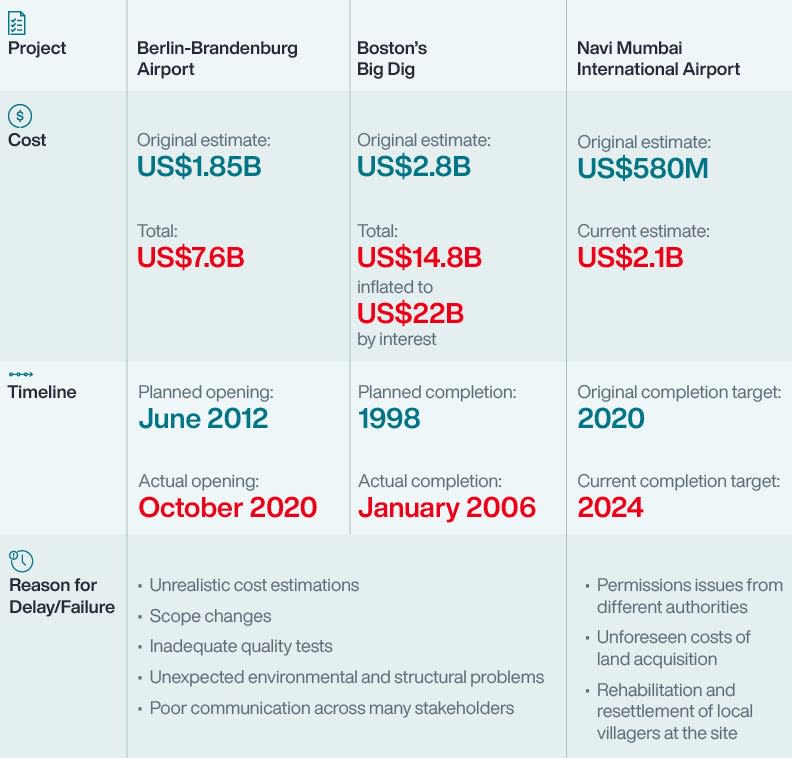Managing Project Risks: 5 Ways Credit Solutions Can Help

Credit insurance tools can help businesses to optimize risk allocation and increase project bankability.
Key Takeaways
-
Poor alignment on risk between public and private stakeholders and inadequate risk allocation across all parties is a common reason for project delays and failures.
-
Credit and political risk insurance can help to mitigate risks and increase funding viability of projects.
-
The key benefits of credit and political risk solutions include enhancing project valuations for investors and sponsors and protecting cash flows.
Project finance has become one of the fastest growing asset classes covered by the credit insurance market. Many underwriters are synthesizing the risk engineering expertise of their construction insurance peers to develop a holistic risk view of infrastructure projects, building their capacity to support all clients involved, from lenders and sponsors to EPC contractors and other stakeholders.
Three major markets in Asia Pacific — Singapore, Australia, and Japan — recognize credit insurance as a regulatory capital relief tool to lower risk-weighted assets, while Malaysia and Taiwan have implemented regulatory policy changes that are leading to greater adoption of credit insurance by local banks.
By increasing the sums lenders can commit to a project, credit insurance solutions are proving to be a boon to capital mobilization. Simultaneously, tailored political risk products can also enhance the bankability of project structures. As global infrastructure development becomes increasingly reliant on project financing methods, credit solutions are emerging as an important tool for optimizing risk allocation and accessing better financing.
“It may be known as credit insurance; however, our industries capabilities go well beyond protection. We facilitate access to new forms of capital, helping to drive growth opportunities in both developed and emerging markets,” says Gary Lorimer, Aon’s Growth Leader for Credit Solutions.
Gaps in Risk Allocation
Project delays and failures are often caused by the poor alignment between public and private stakeholders on risk matters and inadequate risk allocation across all parties. This not only creates exposure to risk events that may occur in the future but can also prevent the project from getting off the ground in the first place, by compromising financing efforts.
From potential issues with credit to construction and supply, businesses must fill all gaps in risk allocation across a project’s ecosystem to enhance funding viability.
“Project risks are multifaceted, interrelated and evolving,” says Stephen Taylor, head of Aon’s Credit Solutions in Asia. “Businesses can benefit from leveraging insurance and alternative capital to safeguard their investments and unlock new opportunities.”
250%
Increase in the number of insurers actively insuring project finance transactions in the last five years.
Source: Mobilising Capital and Enhancing Project Bankability with Structured Credit Solutions
We facilitate access to new forms of capital, helping to drive growth opportunities in both developed and emerging markets.
Five Key Benefits of Credit and Political Risk Solutions
Credit and political risk solutions offer strategic ways to mitigate potential threats and enhance project bankability.
- Securing quality EPC contractors
Having credit solutions in place encourages established Engineering, Procurement and Construction (EPC) contractors to take on projects in challenging contexts knowing that they can limit their own financial losses in case of contractual termination or non-payment. In turn, having experienced contractors on board can reduce construction risk and give peace of mind to potential project backers. - Enhancing valuations for investors and sponsors
Political risk solutions can protect projects against the negative impact on the value of equity investments because of government intervention. For example, critical contracts, such as concession agreements or export licenses can be insured against the risk of termination or breaches by the host government. Sponsors can leverage political risk insurance to reduce country risk in the long term, lowering internal rate of return thresholds for investment decisions. - Protecting project cash flows
Key sources of cash flows for infrastructure projects, such as offtake or power purchase agreements, can be protected through breach-of-contract or non-payment solutions. - Supporting supply chain resilience
Insurance solutions can mitigate performance risk in the supply chain, bolstering resilience in a volatile commodities environment. For example, should a pre-paid balance not be returned following a supplier default, insurance can indemnify the financial loss, thereby absorbing any cash flow impact on the project. In a time of rising fuel costs, mark-to-market credit solutions can mitigate financial losses suffered when an original supplier defaults and the new supply comes at a higher price. - Increasing infrastructure lending capacity
Businesses can gain access to liquidity by ensuring that risk is managed well. Lenders can use insurance capital – covering the credit risk of project loans and bank guarantees – to increase credit facilities. Contractors can also access surety solutions for guarantees issued in various forms throughout the project lifecycle, from bid bonds and advance payment bonds at the project’s start to decommissioning performance bonds upon completion.
Project risks are multifaceted, interrelated and evolving. Businesses can benefit from leveraging insurance and alternative capital to safeguard their investments and unlock new opportunities.
Learning from History
Numerous critical infrastructure projects have suffered huge financial losses that continue to have repercussions. Some controversial examples are:

General Disclaimer
The information contained herein and the statements expressed are of a general nature and are not intended to address the circumstances of any particular individual or entity. Although we endeavor to provide accurate and timely information and use sources we consider reliable, there can be no guarantee that such information is accurate as of the date it is received or that it will continue to be accurate in the future. No one should act on such information without appropriate professional advice after a thorough examination of the particular situation.
Terms of Use
The contents herein may not be reproduced, reused, reprinted or redistributed without the expressed written consent of Aon, unless otherwise authorized by Aon. To use information contained herein, please write to our team.
Aon's Better Being Podcast
Our Better Being podcast series, hosted by Aon Chief Wellbeing Officer Rachel Fellowes, explores wellbeing strategies and resilience. This season we cover human sustainability, kindness in the workplace, how to measure wellbeing, managing grief and more.
Aon Insights Series UK
Expert Views on Today's Risk Capital and Human Capital Issues
Construction and Infrastructure
The construction industry is under pressure from interconnected risks and notable macroeconomic developments. Learn how your organization can benefit from construction insurance and risk management.
Cyber Labs
Stay in the loop on today's most pressing cyber security matters.
Cyber Resilience
Our Cyber Resilience collection gives you access to Aon’s latest insights on the evolving landscape of cyber threats and risk mitigation measures. Reach out to our experts to discuss how to make the right decisions to strengthen your organization’s cyber resilience.
Employee Wellbeing
Our Employee Wellbeing collection gives you access to the latest insights from Aon's human capital team. You can also reach out to the team at any time for assistance with your employee wellbeing needs.
Environmental, Social and Governance Insights
Explore Aon's latest environmental social and governance (ESG) insights.
Q4 2023 Global Insurance Market Insights
Our Global Insurance Market Insights highlight insurance market trends across pricing, capacity, underwriting, limits, deductibles and coverages.
Regional Results
How do the top risks on business leaders’ minds differ by region and how can these risks be mitigated? Explore the regional results to learn more.
Human Capital Analytics
Our Human Capital Analytics collection gives you access to the latest insights from Aon's human capital team. Contact us to learn how Aon’s analytics capabilities helps organizations make better workforce decisions.
Insights for HR
Explore our hand-picked insights for human resources professionals.
Workforce
Our Workforce Collection provides access to the latest insights from Aon’s Human Capital team on topics ranging from health and benefits, retirement and talent practices. You can reach out to our team at any time to learn how we can help address emerging workforce challenges.
Mergers and Acquisitions
Our Mergers and Acquisitions (M&A) collection gives you access to the latest insights from Aon's thought leaders to help dealmakers make better decisions. Explore our latest insights and reach out to the team at any time for assistance with transaction challenges and opportunities.
Navigating Volatility
How do businesses navigate their way through new forms of volatility and make decisions that protect and grow their organizations?
Parametric Insurance
Our Parametric Insurance Collection provides ways your organization can benefit from this simple, straightforward and fast-paying risk transfer solution. Reach out to learn how we can help you make better decisions to manage your catastrophe exposures and near-term volatility.
Pay Transparency and Equity
Our Pay Transparency and Equity collection gives you access to the latest insights from Aon's human capital team on topics ranging from pay equity to diversity, equity and inclusion. Contact us to learn how we can help your organization address these issues.
Property Risk Management
Forecasters are predicting an extremely active 2024 Atlantic hurricane season. Take measures to build resilience to mitigate risk for hurricane-prone properties.
Technology
Our Technology Collection provides access to the latest insights from Aon's thought leaders on navigating the evolving risks and opportunities of technology. Reach out to the team to learn how we can help you use technology to make better decisions for the future.
Top 10 Global Risks
Trade, technology, weather and workforce stability are the central forces in today’s risk landscape.
Trade
Our Trade Collection gives you access to the latest insights from Aon's thought leaders on navigating the evolving risks and opportunities for international business. Reach out to our team to understand how to make better decisions around macro trends and why they matter to businesses.
Weather
With a changing climate, organizations in all sectors will need to protect their people and physical assets, reduce their carbon footprint, and invest in new solutions to thrive. Our Weather Collection provides you with critical insights to be prepared.
Workforce Resilience
Our Workforce Resilience collection gives you access to the latest insights from Aon's Human Capital team. You can reach out to the team at any time for questions about how we can assess gaps and help build a more resilience workforce.
More Like This
-

Article 21 mins
The Optimal Outsourced Chief Investment Officer
For institutional investors, engaging an outsourced chief investment officer, or OCIO, is one of the most critical decisions an organization can make. Choosing the right partner can lead to achieving the desired results or unexpected consequences.
-

Article 6 mins
Credit Solutions Market Overview
Overview of the current trade credit insurance market and outlook on trend developments.
-

Article 16 mins
Building a Future-Ready Workforce for the Professional Services Industry
The need to attract and retain high-quality talent in an environment of intense competition is at the forefront of professional services leaders’ minds.
































































































































